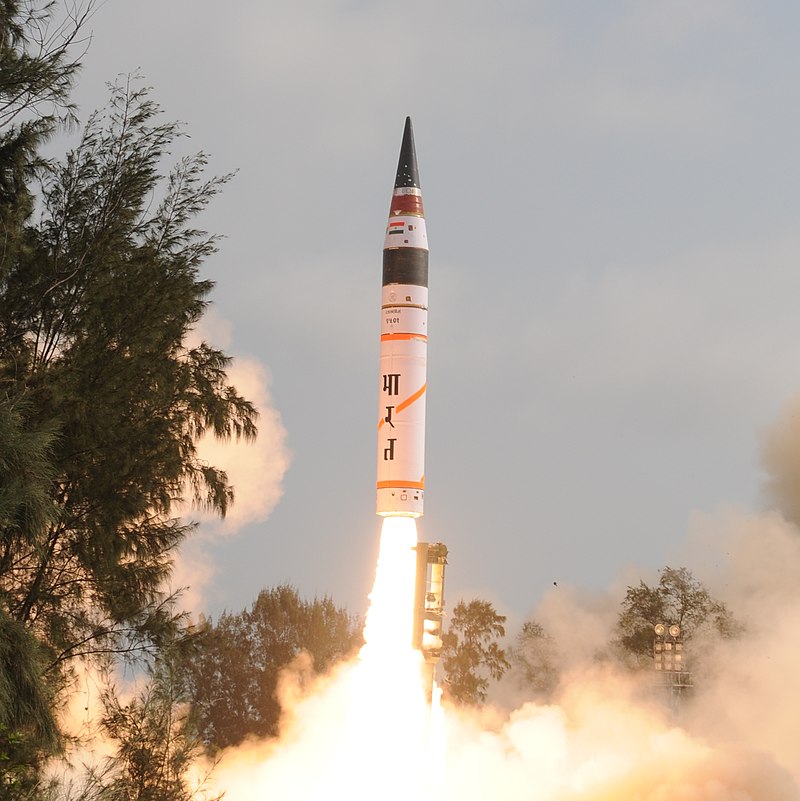
On 11 March 2024 DRDO successfully completed the first flight test of a home-grown missile with multiple independently targetable reentry vehicle (MIRV) technology. This is an important development towards strengthening India’s nuclear triad.
India established its nuclear weapon competence during 1974 when it carried out its first nuclear test (Pokhran-I), this operation was called Smiling Buddha. Subsequently, in 1998 (Pokhran-II), India had carried out a series (five in total) of nuclear tests. However, to establish itself as a credible nuclear power requires proficiency in developing nuclear warheads and various types of weapons delivery platforms. The testing of MIRV technology is an important step towards giving more credence to India’s nuclear deterrence posture.
The process of weaponization of nuclear technology is a complex engineering activity and involves various actions from deciding on the yield necessity, device design, and material acquisition and processing and various other evolutions. The nuclear warhead would be essentially designed based on the weapon system which ultimately would deliver the munitions on the target. Alternatively, the modern day warheads are compressed in size and hence in a position to offer different options for the delivery systems too. Essentially, all such warheads could be delivered from ground, aerial or submarine based platforms. These delivery mechanisms are commonly known together as the nuclear triad. However, to establish a credible nuclear triad it is important to have three major components-the strategic bombers, Long range /Inter Continental Ballistic Missiles (ICBMs) and Submarine Launched Ballistic Missiles (SLBMs). MRIV technology belongs to the category of land-based systems, which are missiles.

Multiple Independently Targetable Re-entry Vehicle (MIRV) technology involves delivering multiple warheads to hit different targets in a single launch of a missile. This is an almost six decade old technology and was first deployed by the United States with the Minuteman III missile, revolutionizing ballistic missile payloads and enhancing strategic capabilities. As per the reports the United States, United Kingdom, France, China and Russia are among the countries that already use MIRV missiles, while Pakistan tested the technology in 2017. On 19 April 2012 the Agni V was successfully test-fired by DRDO, This is an intercontinental ballistic missile (ICBM) capable of reaching a minimum distance of 5000 km. The Agni V can carry a nuclear warhead and is known to have the capability (range) to address any target in both China and Pakistan. The recent testing of MIRV technology is known to be an extension of the Agni V program.
Also Read: Are we living in the age of missile warfare?
Testing of this missile was done under the project Mission Divyastra (divine weapon). MIRVs are known to cause added devastation than traditional missiles that carry a single warhead. The Agni-5 MIRV structure is equipped with indigenous avionics systems and high accuracy sensor packages. The basic challenge for MIRV, which is an exo-atmospheric ballistic missile payload containing several warheads, is about the re-entry into the earth’s atmosphere and reaching the target points within the desired accuracy.

India’s stated nuclear policy is a ‘no first use’ posture, meaning India would never start a nuclear conflict. However, to maintain a credible nuclear deterrence, India needs to demonstrate its capabilities in various technology domains which adds a teeth to its deterrence posture and MIVR testing should be looked at against this backdrop. Today, the Indian air force is fully equipped to undertake nuclear strikes. India’s ICBM capabilities demonstrate the reach of India’s nuclear missile arsenal. By 2018 India has demonstrated its capabilities in the area of submarine launched nuclear-powered ballistic missiles. INS Arihant, successfully completed its first deterrence patrol. With the availability of ballistic missile defence systems (BMD) like S-400 there is a mechanism available to address any incoming nuclear threat. However, India needs to be careful about China’s progress in the arena of hypersonic weapons. The conventional BMD mechanism is not going to have much assistance for hypersonic missiles and some reports indicate that China’s hypersonic program has a nuclear element associated with it.
Also Read: Satan-II – the mother of all missiles in the world
The actual (and factual) information in regards to number of warheads and nuclear yields of the weapons are not likely to be disclosed by any nuclear weapon state. One broad conclusion which could be drawn from the MIRV testing is that India has started focussing on miniaturising technologies for nuclear weapons. Is India also interested in developing tactical nuclear weapons? No definitive conclusions could be drawn in this regard, however India must be monitoring the progress of Pakistan’s tactical nuclear weapons program. Particularly, Chinese MIRV capability offers them both tactical and strategic advantages and enhance nuclear deterrence ability. It is important for India to operationalise the MIRV capability quickly.

